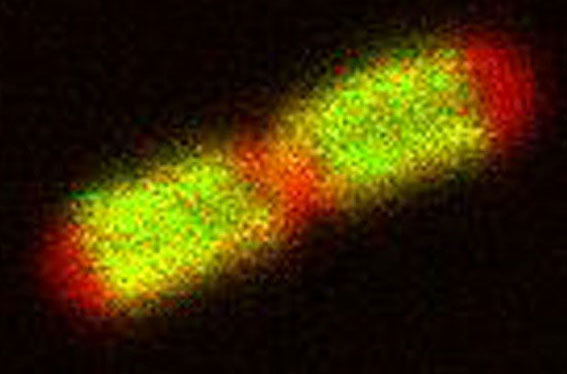
It looks like a fluorescent pill, but this image of an E. coli cell actually shows a new potential target in the fight against infectious diseases. The green highlights a protein called TonB, which is produced by many gram-negative bacteria, including those that cause typhoid fever, meningitis and dysentery. TonB lets bacteria take up iron from the host’s body, which they need to survive. New research from Phillip Klebba of Kansas State University and his colleagues shows how TonB powers iron uptake. When TonB spins within the cell envelope (the bacteria’s “skin”) like a tiny motor, it produces energy that lets another protein pull iron into the cell. This knowledge may lead to the development of antibiotics that block the motion of TonB, potentially stopping an infection in its tracks.
Learn more:
Kansas State University News Release ![]()
Klebba Lab ![]()
Other Cool Images


If E-coli is gram negative, other intestinal bacteria may also be gram negative. So, an anti-bacterial which kills typhoid and other pathogens may also kill our intestinal bacteria, and immobilize us. There must be a better way to attack pathogens. I think we should start, not with something which is common with many other bacteria, but the peculiarity which distinguishes them. I also think we have to get off the notion that anti-bacterial medication is not anti-human system medication.
Jacob,
You are correct that many of the commensal bacteria in the human and animal gut are also Gram-negative, and therefore susceptible to pharmaceutical drugs and antibiotics that target Gram-negative bacterial pathogens. But, this is not a problem that prevents antibiotic treatment. It’s often necessary to eliminate a bacterial pathogen in order to save a person’s or animal’s life. Even if all the bacteria in the intestinal tract are eliminated by an antibiotic, it’s relatively simple and straightforward to re-colonize the gut with non-pathogenic organisms. And the antibiotics that we envision against bacterial iron uptake systems will not affect human or animal iron uptake systems, because they act by different mechanisms conferred by different proteins. We can specifically target the bacterial systems because they are distinct from the animal iron transport systems.